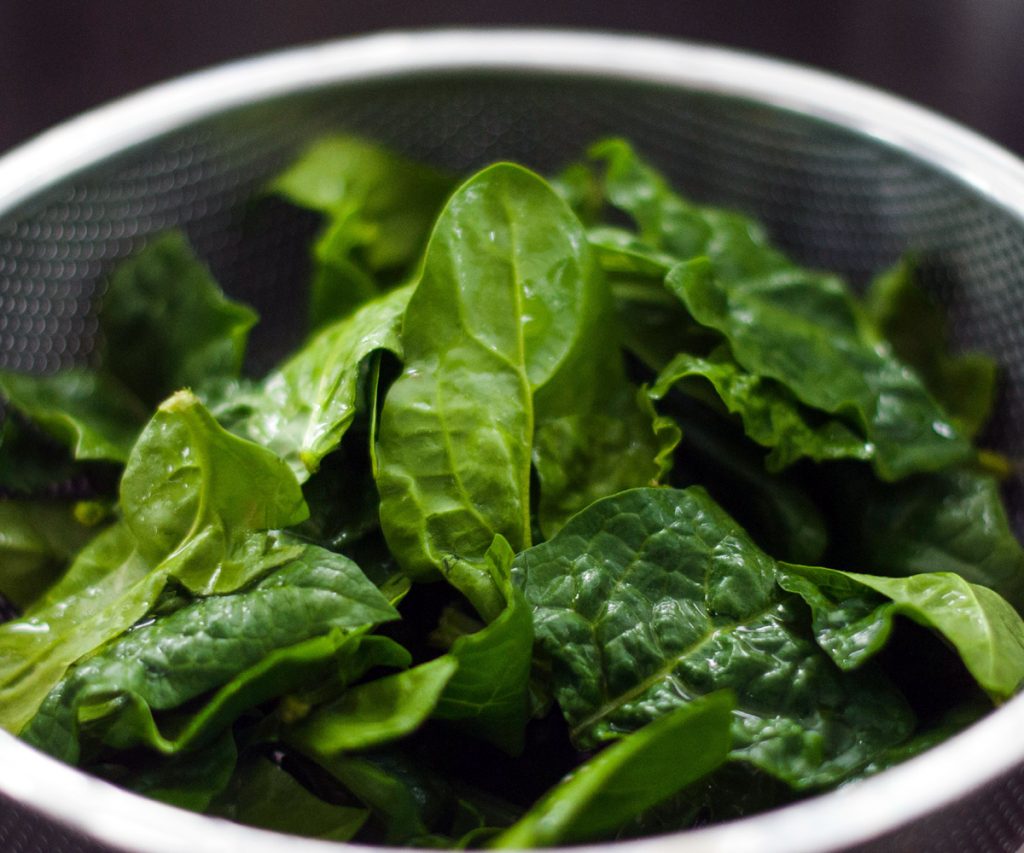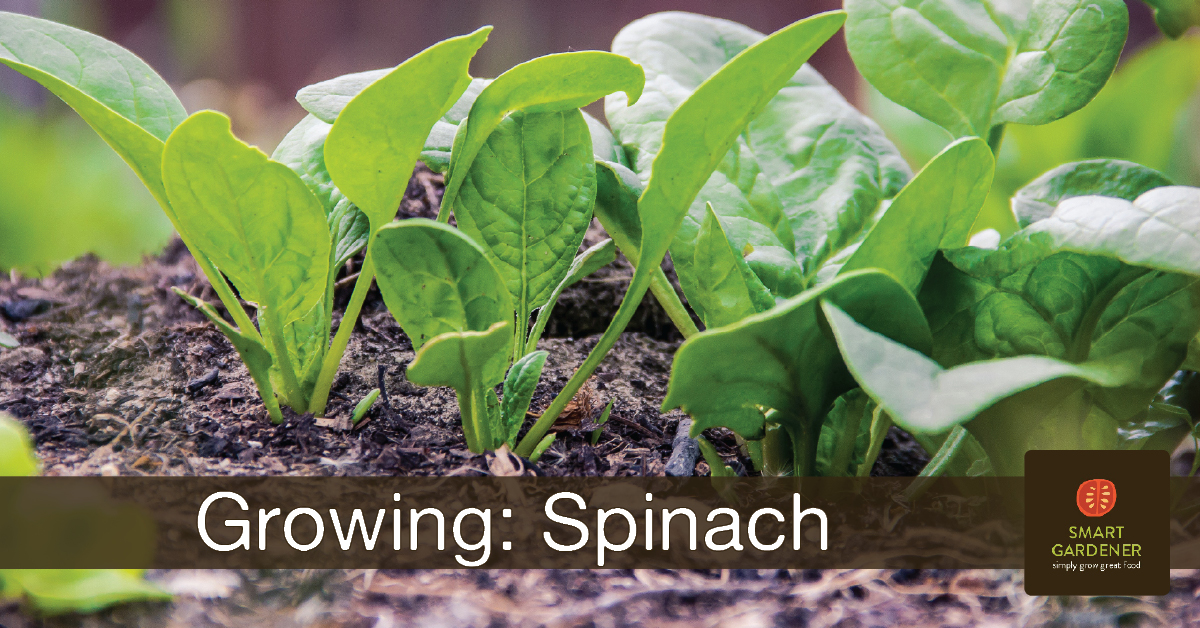
Spinach is an easy and fast plant to grow for garden-fresh salads.
Other greens may get all the attention, but spinach is more than just a cartoon gimmick. It’s full of iron and calcium, as well as a wealth of antioxidants. And it’s super easy to grow! Below we have some tips for growing spinach that will make it easy even for first time gardeners.
Selecting Which Varieties to Grow

There are two types of spinach (Spinacia oleracea) you can grown, each with its own characteristics that make it better suited to different gardens. When selecting which variety of spinach to include in your garden, keep in mind your climate and how you would like to eat it.
Smooth-Leaf
Smooth Leaf Spinach is the most popular type of spinach on the West Coast. It is smooth and easy to clean. Under good growing conditions, Smooth Leaf Spinach can be one of the fastest growing crops. Delicious in salads, these smooth-leaved varieties like Catalina, Merlo Nero, and the French heirloom Monstrueux De Viroflay are considered superior for this, as the leaves are also easier to clean.
Savoyed-Leaf
Savoyed Leaf Spinach is gaining popularity throughout the U.S. The leaf shape is curled making it a bit more difficult to clean, but it makes up for the extra work with flavor, and varieties like Summer Perfection, Tyee, and Bloomsdale have been bred to be slow-bolting. Plus, Savoyed Leaf Spinach is one of the fastest growing crops under good growing conditions, with harvest starting at just under 40 days.
Tips for Growing Spinach
Location & Soil Preparation
Spinach needs full sun for good growth, particularly for a fall or over-wintering crop. Spinach doesn’t like heat and in warmer areas it should be planted in a shady site.

A light, well-drained soil works best because spinach is grown in cool weather and such soils warm up faster. Spinach likes organic matter, so it’s important to prepare your soil before planting. Incorporate 2″ of compost or aged manure into the top 6″ of soil (where most feeder roots are found). The ideal soil is rich in humus, moisture retentive, and contains lots of nitrogen and potassium. In fact, spinach loves manure and will even thrive in soil containing fresh manure (though ideally this should be incorporated into the soil the previous autumn).
This plant is quite sensitive to pH, and prefers a pH of 6.0-7.0, with 6.3-6.8 as ideal. Both extremes may cause problems, so for the best crop it’s important to adjust your soil’s pH if it’s outside this range.
Spinach is quite tolerant of saline soils.
Sowing & Thinning
Each plant doesn’t produce very much, so it is usually grown in wide intensive beds. Raised beds are good because they warm up quickly in spring and tend to be well drained.
This fast growing plant makes an excellent salad mix crop, sown 1/2″ to 1″ apart. Spinach can bolt if overcrowded, so thin the plants carefully to 2″ to 4″ apart when they have all emerged.
Plant Care
Spinach must grow quickly to produce the highest quality food. This means giving it optimal conditions; as much water and nutrients as it requires and no competition from weeds or crowding neighbors (all these factors can contribute to bolting).
Pinching out the leaves encourages new growth, so keep it cropped even if you don’t need it. If the leaves get tough, try cutting the whole top off of the plant, leaving about 3″ to re-sprout.
Plant Protection
Spinach is commonly attacked by leaf miners. If they become very bad you may have to protect them by covering with a layer of row cover.
Pollination & Seed Saving
Spinach is wind pollinated and to keep it pure it must be isolated from other varieties by at least a 1/2 mile. Female plants may grow to 4 feet in height and produce a lot of seed.
Spinach plants are dioecious (there are separate male and female plants) so all plants don’t produce seed. Saving seed is fairly straightforward, you just allow a patch of plants to bolt, which they will eventually do anyway. The first plants to bolt are males, which have smaller leaves. You don’t need a lot of males, but some are necessary for fertilization (keep 1 male for every 2 females). Don’t gather seed from the first females to appear, as you don’t want to create an early flowering strain.
Alternative Growing Options
Interplanting
When grown in ideal conditions, spinach is very fast growing and makes a useful catch crop for interplanting between slower growing crops.

Cut-and-Come-Again
In milder areas spinach will continue to grow right through the winter and doesn’t bolt in the short cool days. As a result the plants stay productive for much longer, so it’s usually better to harvest individual leaves. Individual leaves are gathered as they reach a useful size, anywhere from 2″ to 5″ depending on your preference. Just don’t let them get much bigger than about 6″ as they get tough and would need to be cooked.
Harvest individual leaves regularly by carefully pinching off or snipping each leaf. Be sure not to take too many leaves from any one plant. Always leave at least 6 leaves on the plant, which is enough to enable the plant to regenerate. Spinach works very well when grown in this way, as bolting isn’t as much of a problem when you are continuously harvesting smaller leaves.
Container Gardens
Spinach can work well in containers, though they need to be sufficiently large (ideally a two gallon pot for each plant). In larger containers allow 12″ between the plants for best growth. In warmer areas you should use light colored pots to keep the soil from getting too warm.
Winter Gardens
In areas with mild winters, you can grow some varieties of spinach as a winter crop. They are hardy down to 25˚ F and don’t bolt in the cool, short days. In colder climates, it can be grown under the cover of cloches or cold frames.
The key to success as a winter crop is for the plants to get big enough before cool weather hits. They will then continue to grow throughout the winter.
Smart Gardener makes it easy to start a garden. We can help you decide which varieties of spinach will work best in your garden and give you the advice you need to get started, and then send you weekly to-dos to keep you on track!


